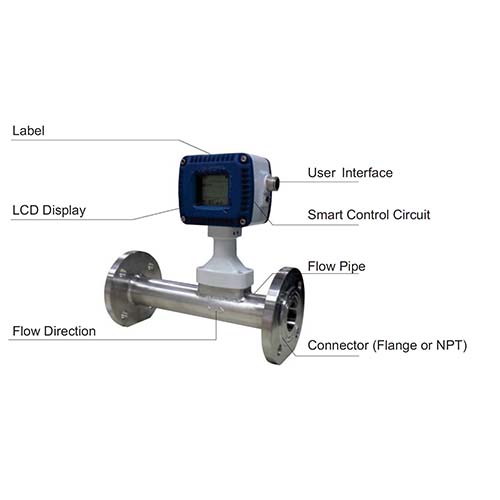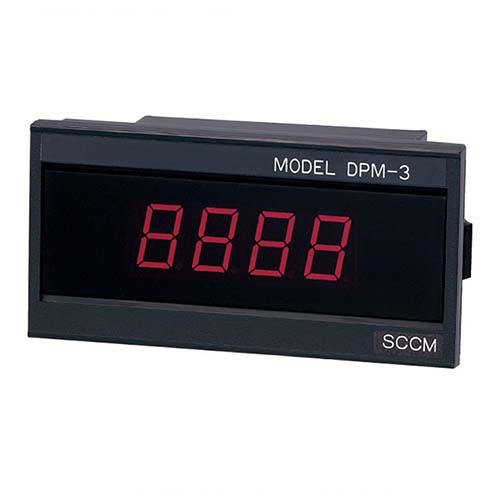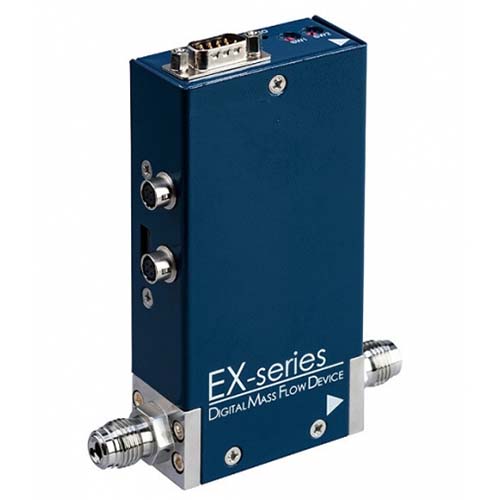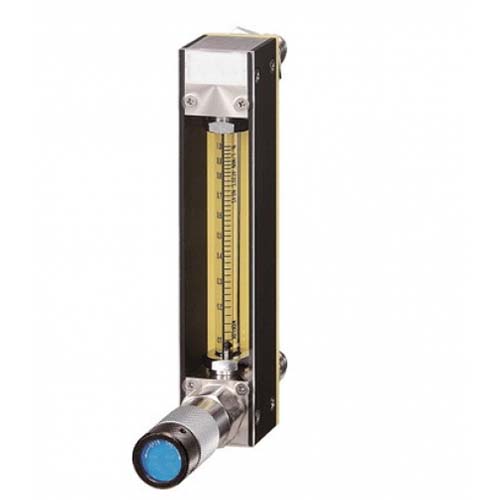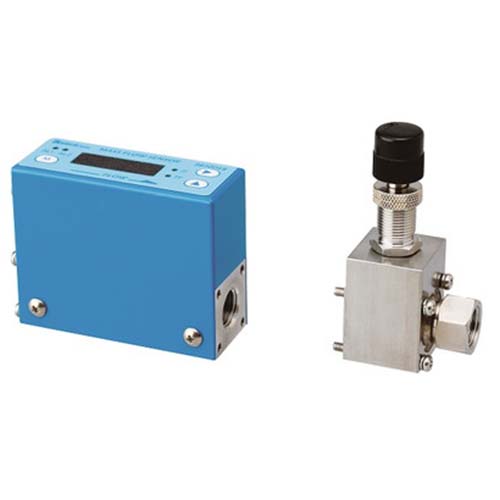FGT think your best choice in the future
System Integration Designers in FGT
TMFM1500 Type: Mass Flow Meter
Suppose you want to provide gas for a chemical gas mixing process, then a mass flow controller is the right device. They are used in the following processes:
Add gas to mixing tubing to facilitate ratio adjustment
- Industrial gas mixing piping or gas generator flow monitoring
- Add mixed gas to plasma generating supply
In all of these examples, the process requires a repeatable and accurate supply of gas compounds. This allows you to proceed in a controlled manner with optimum product yield and minimal risk of poor or excessive process performance, such as wasting unused gaseous reactants or runaway processes. Mass flow controllers are used for this purpose.
- Description
- Technical Specifications
- Application
- Flow range
- Ordering Information
- IoT software
- certified
- Special needs
- Inquire now
TMFM1500 Mass Flow Meter | Gas Flow Control
- High precision performance at low flow rates
- Response speed (≦1.0)
- High connection compatibility
- high stability
- Corrosion resistance value
- excellent linearity
- Excellent long-term stability
- Modular design
- Compact Flow Control System
What is a Thermal Mass Flow Meter?
Thermal Mass Flow Meteris an accurate, easy-to-install, low pressure drop flowmeter. It is suitable for flow measurement and control of dry gas applications. can alsoby gas typeReference linkapplication toObtain a thermal mass flow meter. A mass flow meter observes the cooling effect on the transducer it heats as a function of airflow. The result achieves a high level of accuracy at low cost compared to other gas flow measurement devices.
benefit:
- ·High accuracy
- Wide flow range, including low flow
- · Simple, durable construction
- ·Easy to install and maintain
- Flexible connection of flow meters for flow control
- · Various process connections
- ·Tuning ratio 100:1
- Low pressure drop across the flow meter
- ·Provide convenient signal output
Thermal Mass Flow Meter Principle
Thermal Mass Flow MeterUse the thermal properties of the fluid to measure the motion of the fluid in a pipe or tube. In a thermal energy flow meter, the measured heat is applied to the heater of the sensor. A certain amount of energy is lost during the flow, and as the flow increases, more energy is lost. The energy lost by the sensor depends on the thermal properties of the fluid and the sensor design. The thermocompressive properties of fluids can vary with temperature and pressure, although these changes are usually insignificant in most applications. Since thermal flow measurement does not depend on the temperature or pressure of the fluid, thermal energy flow meters can be used to estimate the mass flow of the fluid.
In other words, in most applications, the properties of a fluid may depend on its composition. For these applications, different compositions of the fluid may interfere with the heat flow size during actual operation. Therefore, forThermal Mass Flow MeterIt is important for the provider to understand the composition of the fluid so that the appropriate normalization factors can be processed to accurately determine the flow rate. Due to this limitation,Thermal Mass Flow MeterUsually used to measure the flow of pure gas. Manufacturers can provide appropriate standardized information for other gas combinations, butThermal Mass Flow MeterThe accuracy of the depends on whether the actual gas mixture is the same as the gas mixture used for normalization purposes.
Mass Flow Controller Applications
- Plasma Cleaner
- Gas diverter valve box/panel
- Gas cylinder cabinet output flow control
- Gas generator output control
- flame welding control
- Gas source piping measurement
What types of mass flow controllers exist in the TMFM/TMFC series?
Thermal mass flow controllers use the thermal mass sensing technique of gases to control their mass flow. In the TMFC portfolio we have several thermal mass flow controllers, each with its own sensor technology:
Mass flow controllers using bypass sensors. These devices, such as TMFCs and TMFMs, are ideal for clean and dry gas applications where greater precision and repeatability are required.
Mass flow controller using the on-line principle. Series such as the TMFC and TMFM series are perfect if your application has high purity gases above 99.9%, or when high repeatability and robustness are more important than accuracy.
Gas mass flow controller using piping control technology. These series stand out because they can measure gas flow and control.
Whenever your mass flow needs to be displayed and over a wide flow range, a gas series using MEMS chip sensor technology such as the TMFM6000 is perfect.
Gas mass flow controllers using in-line (CMOS) technology.
Mass Flow Controller ( MFC ) Principle / Flow Controller Principle
A mass flow controller (MFC) is a device used to measure and control the flow of liquids and gases. [1] Mass flow controllers are designed and calibrated to control a specific type of liquid or gas over a specific flow range. The MFC can have a set point between 0% and 100% of its full scale range, but typically operates within the full scale range of 10% to 90% for best accuracy. The device will then control the flow rate to the given set point. MFCs can be analog or digital. Digital flow controllers are usually capable of controlling more than one fluid, while analog controllers are limited to the fluids they are calibrated for.
All mass flow controllers have an inlet port, an outlet port, a mass flow sensor, and a proportional control valve. The MFC is equipped with a closed loop control system where the operator (or external circuit/computer) provides an input signal which is compared with the value of the mass flow sensor and adjusts the proportional valve accordingly to achieve the desired flow. Flow is specified as a percentage of its calibrated full scale flow and is provided to the MFC as a voltage signal.
Mass flow controllers require the supply gas or liquid to be within a specific pressure range. Low pressure will deplete the MFC of fluid and prevent it from reaching its set point. High pressures may cause erratic flow rates. There are many different technologies that help measure the flow of fluids and ultimately help control flow. These technologies define the types of mass flow controllers and they include differential pressure (ΔP), differential temperature (ΔT), Coriolis force, ultrasonic, electromagnetic, turbine, etc.

Mass Flow Meter Installation
Now there are more and more applications of mass flowmeters, and some occasions where mass flowmeters are installed for the first time are not clear about the installation method of mass flowmeters, reverse installation, wrong installation, etc., which affect the normal use of the equipment. This article discusses this problem Describe in detail how to install a mass flow meter.
Excessive mechanical stress during sensor installation will affect the zero point of the mass flowmeter. If these stresses are constantly changing, the zero point drift of the meter will cause inaccurate measurement and cannot work normally. Therefore, the correct installation of the mass flowmeter is an important part of ensuring the normal operation of the equipment.
1. Choose the installation method
The installation method of the sensor is mainly determined according to the phase difference of the fluid and its process conditions. There are three installation methods.
1. If the measured fluid is a liquid, the sensor is generally installed with the shell facing down to avoid air accumulation in the vibrating tube of the sensor, so as to achieve the purpose of accurately measuring the mass flow rate.
2. If the measured fluid is gas, the sensor is generally installed with the shell facing upwards to avoid accumulation of condensate in the sensor vibration tube.
3. If the measured fluid is a mixed slurry of liquid and solid, install the sensor on a vertical official road, which can prevent particles from accumulating in the sensor's Coriolis force measuring tube. In addition, if the process pipeline needs to be cleaned with gas and steam, this installation method can also facilitate cleaning, but this installation method is more difficult to fix than the previous two, and the pressure loss is larger.
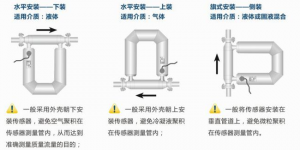
gas flow controller
gas mass flow controllers
Mass Flow Formula
Types of mass flow meters
mass flow meter english
according toThree degrees Chinese website.Multiple interpretations mass flowmeter【electronic computer term】mass flow meter【mechanical engineering】mass flowmeter sensor【marine science term-underwater engineering】thermal mass flow【electronic engineering】mass flow measurement【electrical engineering】
Technical Specifications
| series | TMFM15F | TMFM15N | TMFM15B | TMFM15S |
| Flow range (N2) | 1.0~1600Nm3/h | 1.0~1600Nm3/h | 1.0~1600Nm3/h | 1000~400000Nm3/h |
| reaction speed | ≦1.0sec | |||
| precision | ±1.5 % FS | |||
| Reproduction accuracy | ±0.75 % FS | |||
| Pressure resistance | 0.1~1.5 Mpa | |||
| leak rate | 1 x 10-9 atm.cc/sec or less | |||
| Operating temperature | -20~65℃;<95%RH | |||
| Materials for contact parts with gas | Body: SUS316 | |||
| Connection method | Flange | NPT | BSPT | Insertion |
| Ball valve | without | have | ||
| Wifi connection | Zigbee Wifi modbus RS485 | |||
| Flow output signal | 0~5 Vdc;4~20mA,:Pulse;RS-485;RS-232 | |||
| APP software | Support:iOS/Andriod | |||
| Supply voltage | +8~24Vdc | |||
Application
What is MFM
A mass flowmeter, also known as an inertial flowmeter, is a device that measures the mass flow of a fluid through a pipe. Mass flow rate is the mass of fluid passing a fixed point per unit of time.
A mass flow meter does not measure the volume per unit of time (eg, cubic meters per second) passing through the device; it measures the mass per unit of time (eg, kilograms per second) flowing through the device. Volume flow is mass flow divided by fluid density. If the density is constant, the relationship is simple. The relationship is not simple if the fluid has a varying density. The density of fluids may vary with temperature, pressure or composition. The fluid can also be a combination of phases, such as a fluid with entrained air bubbles. Since the speed of sound depends on the controlled liquid concentration, the actual density can be determined. [1]
MFM application
1. Smart Pipe Monitor
The main reason thermal mass flow meters are popular in industrial applications is the way they are designed and manufactured. They have no moving parts, have virtually no obstruction to a straight flow path, require no temperature or pressure correction, and maintain accuracy over a wide flow range. Straight pipe runs can be reduced by using a double plate flow conditioning element, and the installation is very simple and does not cause pipe intrusion.
However, in many applications the thermal properties of the fluid may depend on the fluid composition. In such applications, changes in fluid composition during actual operation can affect heat flow measurements. Therefore, it is important for thermal flow meter suppliers to understand the composition of the fluid so that the appropriate calibration factors can be used to accurately determine flow. Vendors can provide appropriate calibration information for other gas mixtures, but the accuracy of thermal flow meters depends on the actual gas mixture being the same as the one used for calibration purposes. In other words, the accuracy of a thermal flow meter calibrated for a given gas mixture will be reduced if the gas actually flowing has a different composition. [2]
2. CVD machine
What is CVD
Vapor deposition (CVD) is a vacuum deposition method used to produce high-quality, high-performance solid materials. This process is commonly used in the semiconductor industry to produce thin films.
In typical CVD, the wafer (substrate) is exposed to one or more volatile precursors that react and/or decompose on the surface of the substrate to produce the desired deposits. Volatile by-products are also typically produced, which are removed by the gas flow through the reaction chamber.
Microfabrication processes widely use CVD to deposit various forms of materials including: single crystal, polycrystalline, amorphous and epitaxy. These materials include: silicon (carbon dioxide, carbides, nitrides, oxynitrides), carbon (fibers, nanofibers, nanotubes, diamond and graphene), fluorocarbons, filaments, tungsten, titanium nitride and various high k dielectric.
3. Valve Box/Panel (VMB/VMP)
What is VMB/VMP
Through our experience in handling gases, we have gained the knowledge to design and manufacture panels (gas boxes) for EPI systems, MOCVD, material supply systems and more.
Among our business achievements, we are able to design and manufacture products that meet customer requirements (price and specifications). We can handle not only normal gas but also liquefied gas supply for hub rings. We also support various legal applications.
Flow range
| series | TMFM15F | TMFM15N | TMFM15B | TMFM15S |
| Flow range (N2) | 1.0~1600Nm3/h | 1.0~1600Nm3/h | 1.0~1600Nm3/h | 1000~400000Nm3/h |
| reaction speed | ≦1.0sec | |||
| precision | ±1.5 % FS | |||
| Reproduction accuracy | ±0.75 % FS | |||
| Pressure resistance | 0.1~1.5 Mpa | |||
| leak rate | 1 x 10-9 atm.cc/sec or less | |||
| Operating temperature | -20~65℃;<95%RH | |||
| Materials for contact parts with gas | Body: SUS316 | |||
| Connection method | Flange | NPT | BSPT | Insertion |
| Ball valve | without | have | ||
| Wifi connection | Zigbee Wifi modbus RS485 | |||
| Flow output signal | 0~5 Vdc;4~20mA,:Pulse;RS-485;RS-232 | |||
| APP software | Support:iOS/Andriod | |||
| Supply voltage | +8~24Vdc | |||
Ordering Information
| Order model | ||||||||||||
| TMFM15 | coding | Pipe diameter | ||||||||||
|
|
F00025 | DN25mm (for flange connection type) | ||||||||||
| F00032 | DN32mm (for flange connection type) | |||||||||||
| F00040 | DN40mm (for flange connection type) | |||||||||||
| F00050 | DN50mm (for flange connection type) | |||||||||||
| F00065 | DN65mm (for flange connection type) | |||||||||||
| F00080 | DN80mm (for flange connection type) | |||||||||||
| F00100 | DN100mm (for flange connection type) | |||||||||||
| N00025 | DN25mm (for NPT connection type) | |||||||||||
| N00032 | DN32mm (for NPT connection type) | |||||||||||
| N00040 | DN40mm (for NPT connection type) | |||||||||||
| N00050 | DN50mm (for NPT connection type) | |||||||||||
| B00025 | DN25mm (for BSPT connection type) | |||||||||||
| B00032 | DN32mm (for BSPT connection type) | |||||||||||
| B00040 | DN40mm (for BSPT connection type) | |||||||||||
| B00050 | DN50mm (for BSPT connection type) | |||||||||||
| SXXXX | SXXXX code for DN80~1600mm (pin for plug-in connection type) | |||||||||||
|
|
coding | Ball valve | ||||||||||
| N | Not Available (For Flanged/NPT/BSPT Types) | |||||||||||
| W | Ball valve (insertion type) | |||||||||||
|
|
coding | Riot class | ||||||||||
| E | Explosion-proof grade | |||||||||||
| X | No explosion-proof grade | |||||||||||
|
|
coding | output type | ||||||||||
| W | Wifi+RS485 (standard type) | |||||||||||
| V | 0~5Vdc | |||||||||||
| A | 4~20mA | |||||||||||
| B | RS-485 | |||||||||||
| C | RS-232 | |||||||||||
| D | Pulse | |||||||||||
|
|
coding | Minimum flow | ||||||||||
| xx | Nm3/hr (eg 0.5 Nm3/hr =05 | |||||||||||
|
|
coding | Maximum flow | ||||||||||
| XXX | Nm3/hr (eg 450 Nm3/hr =450 | |||||||||||
|
|
coding | maximum working pressure | ||||||||||
| xx | Mpa (eg 1,5 Mpa=15) | |||||||||||
|
|
coding | gas type | ||||||||||
| A | Air | |||||||||||
| N | Nitrogen (N2) | |||||||||||
| O | Oxygen (O2) | |||||||||||
| R | Argon (Ar) | |||||||||||
| C | carbon dioxide (CO2) | |||||||||||
| E | Helium (He) | |||||||||||
| H | Hydrogen (H2) | |||||||||||
| S | For special gases, please contact our service center | |||||||||||
|
|
||||||||||||
| TMFM15 | Complete order model | |||||||||||
| *Note: All models come with power supply (+8 to 24 Vdc) | ||||||||||||
| *Note: OEM orders are available for orders over 100 | ||||||||||||

